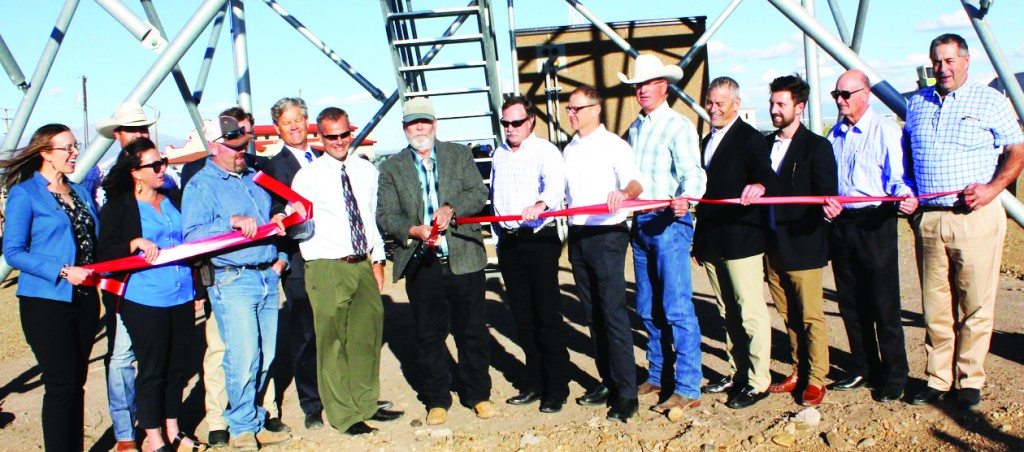Radar becomes reality

ALAMOSA — There was plenty to celebrate at the ribbon cutting for the new Doppler Radar at the San Luis Valley Regional Airport on Wednesday evening. Thanks to the collaboration of numerous public and private partners, a project that began as a dream is now reality.
The story of bringing Doppler radar to Alamosa began with Joe Busto, a staff member for the Colorado Water Conservation Board. Busto recognized a gap in forecasting ability within the Rio Grande Basin. Busto began working with Ken Howard of the National Severe Storms Laboratory at NOAA who also recognized the forecasting gap. As a result, the two began working to bring awareness of the need for a radar system in the Valley.
Because of the potential of improved moisture and severe weather forecasting, the concept began to attract interest and support from local entities such as the Rio Grande Water Conservation District, the Conejos Water Conservancy District, and the Rio Grande Watershed Emergency Action Coordination Team (RWEACT). The CWCD began to take the lead in the effort which resulted in a test period where temporary radar systems were brought in from outside sources. When the benefits of radar were discovered, there was consensus that a permanent system was needed in the Valley. The project also earned the support of the Colorado Water Conservation Board.
Gigi Dennis, Alamosa County Administrator, noted that when the discussions about permanent radar began, the County was approached about the possibility of providing land where a structure could be established. The effort to acquire property and build a permanent system was led by Heather Dutton of the San Luis Valley Water Conservancy District, Nathan Coombs of CWCD, and Cleave Simpson of RGWCD.
Alamosa County agreed to join in the effort and a portion of land adjacent to the San Luis Valley Regional Airport was chosen as the site. Dennis explained that the airport was found to be the central point of the Rio Grande Basin, and thus, would serve as an ideal location. The next step in the process was to choose a contractor. Following a bid process, the project was awarded to EWR Weather Radar Systems of St. Louis, Mo. Guy Blase, CEO of EWR Systems noted that it the project has been a “Great opportunity to fill a gap for the local community.”
Dennis further noted that since the project cost totals to approximately $1.3 million, there has been numerous sources of outside funding that have played a key role in the project. This has included $300,000 from Capitol Development Committee as well as support from the Colorado Department of Transportation.
Because of a combined effort, the Valley is now home to a piece of State-of the Art technology. Blase noted that the new system is among the first of its’ kind and is considered “world-class.” The new radar site is at the cutting edge of technology and will utilize it also expected to be a “show and tell” destination. Howard pointed out that the new system is expected to not only improve local forecasting; it will also provide data that can be used for the National Weather Service. Howard was also quick to acknowledge the foresight and collaboration of the local stakeholders and hailed them as “trail blazers.”
During the ceremony, Craig Cotten of the Division of Water Resources noted that the radar will play a crucial role in the Rio Grande Basin’s water supply forecasting and the administration of the Rio Grande Compact. He went on to call the potential benefits of improved forecasting “tremendous.” Travis Smith of RWEACT observed that the unit is an asset for public safety since it can be used for post-fire rain event monitoring and flood detection. Smith also went to highlight how the project’s partners came together to meet a challenge. “We can do great things if we don’t care who gets the credit,” he said. Matt Muraro of CDOT expressed that the radar will also contribute to the improvement of transportation management for the region. Richard Chappuis of EWR Systems explained that the unit is equipped with Dual Polarization Technology, which will allow it to detect a vast range of weather phenomena. Howard hailed the project as a “Giant step forward,” in relation to filling the gaps that exist in NOAA’s system. Simpson concluded the ceremony by noting that the future of the system is dependent on consistent funding sources and noted that the water community is committed to the long-term success of the initiative.
With the establishment of the radar now realized, the collection of data is underway and a website where the data can be accessed is forthcoming. The unit stands as a testament to what can happen when cooperation takes place.



